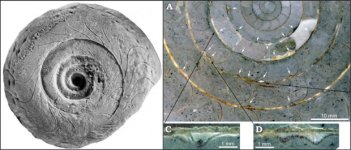Donna,
This was going on the Nautilus thread late last evening but I nodded off before I could finish my post! Better here, because this deserves a discussion of its own.
Ammonites figured prominently in the Nautilus thread at one point
(POST 663) via a study of the microstructure of ammolite, the preserved nacre of Cretaceous ammonites from Alberta's Bearpaw formation (it should be clarified here that referring to ammonites as ancestors of Nautilus is not academically correct, they actually co-existed through the Cretaceous period but are different branches of the Cephalopod family, Nautilus adapted to ever-increasing water depths, the probable cause of its survival of the Cretaceous-Tertiary extinction that wiped out not only ammonites, but the dinosaurs).
The 'pearls' in this study are exclusively blisters with no evidence or suggestion of a loose whole pearl, like the blisters on Nautilus shells I have collected and photographed. But what an incredible infestation, and conviviality between parasite and host, was occurring in Devonian Morocco 400 million years ago!
Below is a composite of images from De Baet's paper showing the numerous blister impressions on the ammonite mold (called 'Housean pits' after Michael House, who first studied them in 1960), and the longitudinal cross section that revealed the organic-tube parasite remnants within the blisters themselves, eliminating several alternative hypotheses and resulting in this publication.
Basically, this reconfirms what we already know, that pearls are a normal byproduct of animal biology in reaction to stress. The discussion presented in the Nautilus thread is not
whether Nautilus produces pearls, but rather the nature of their composition.

